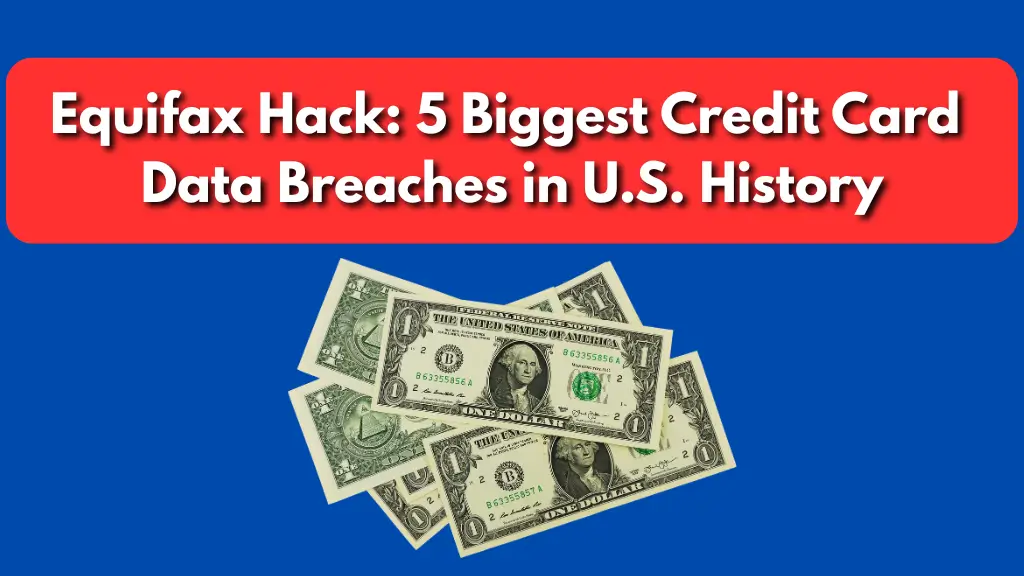Data breaches have become a significant concern for consumers and businesses alike. Credit card data breaches, in particular, have exposed millions of individuals to financial fraud and identity theft. In this article, we explore the five most notorious credit card data breaches in U.S. history, including the infamous Equifax hack, and how these breaches have reshaped cybersecurity protocols over the years.

1. Equifax Hack (2017) – 143 Million Customers Exposed
The Equifax data breach in September 2017 remains one of the most devastating cyberattacks in history. Hackers exploited a vulnerability in the company’s web application software, compromising the personal information of 143 million Americans.
- Exposed Data: Names, Social Security numbers, credit card numbers, and addresses.
- Financial Fallout: Equifax agreed to pay up to $700 million in settlements, including compensation for affected customers.
- Impact on Cybersecurity: The breach underscored the importance of patching software vulnerabilities promptly and implementing stronger data encryption methods.
2. Capital One Breach (2019) – 106 Million Customers Affected
In July 2019, Capital One, a top credit card issuer, revealed that a hacker accessed sensitive information belonging to 106 million individuals in the U.S. and Canada.
- Targeted Data: Names, Social Security numbers, dates of birth, and credit scores.
- Method of Attack: A former Amazon Web Services (AWS) employee exploited a vulnerability in Capital One’s cloud server.
- Financial Impact: The breach resulted in over $80 million in fines and compensation.
3. Home Depot Breach (2014) – 56 Million Cards Compromised
In 2014, Home Depot was targeted in a sophisticated cyberattack involving custom-built malware. The breach exposed the payment information of 56 million customers who made purchases at the retailer’s stores.
- Breach Tactics: Hackers installed malware on Home Depot’s point-of-sale systems to steal credit card data.
- Financial Repercussions: The company paid $134.5 million to credit card networks and $19.5 million to customers affected by the breach.
4. Heartland Systems Hack (2009) – 160 Million Cards Exposed
The Heartland Systems breach in 2009 remains one of the largest payment card data breaches to date, involving the theft of 160 million credit and debit cards.
- Data Exposed: Payment card numbers, expiration dates, and magnetic stripe data.
- Hacker Involvement: The attack was orchestrated by a group of cybercriminals who also targeted retailers such as 7-Eleven and Nasdaq.
- Consequences: Heartland was forced to pay over $60 million in settlement costs to Visa, MasterCard, and other affected parties.
5. TJX Companies Breach (2006) – 94 Million Cards Compromised
The TJX Companies breach in 2006 affected popular retail brands like TJ Maxx and Marshalls, resulting in the exposure of 94 million payment cards.
- Breach Strategy: Hackers intercepted wireless network communications to access payment card data.
- Financial Losses: TJX paid approximately $41 million to Visa, $24 million to MasterCard, and $9.75 million in settlements to state governments.
- Impact: The incident highlighted vulnerabilities in Wi-Fi security and the need for stronger encryption protocols.
Why Credit Card Data Breaches Continue to Happen
Despite advancements in cybersecurity, credit card data breaches persist due to evolving hacking techniques and insufficient security measures. Hackers are now focusing on targeted attacks rather than mass data breaches, seeking specific information like passwords and email addresses to carry out sophisticated fraud schemes.
Notable Trends in 2025:
- Rise of Ransomware: Cybercriminals are increasingly using ransomware to lock down company systems and demand payments.
- Phishing Attacks: Attackers are targeting employees to gain access to secure networks through deceptive emails.
- Data Encryption: Companies are investing in stronger encryption methods to protect sensitive financial data.
Read Also:
T-Mobile Data Breach Settlement Payments Out: How to Check Your Eligibility
FAQs
1. How Can I Protect My Credit Card Information?
- Regularly monitor your bank statements for unauthorized transactions.
- Use strong, unique passwords for online banking and credit card accounts.
- Enable two-factor authentication (2FA) for added security.
2. What Should I Do If My Data Was Compromised?
- Contact your bank to freeze or cancel affected cards.
- Set up fraud alerts with credit bureaus like Equifax, Experian, and TransUnion.
- Consider enrolling in identity theft protection services.
3. Why Are Data Breaches Becoming More Targeted?
Hackers are now focusing on quality over quantity, seeking specific data such as passwords, email addresses, and personal identification numbers (PINs) to commit targeted fraud.
4. Are Companies Liable for Data Breaches?
Yes, companies found negligent in protecting customer data can face lawsuits, fines, and regulatory penalties.